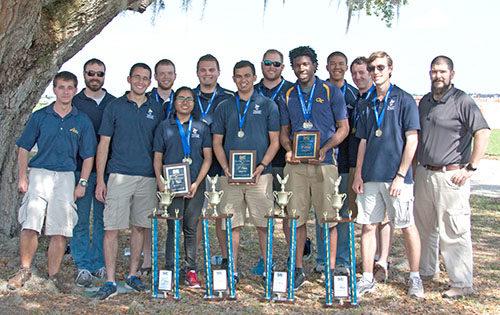
A team of 35 graduate and undergraduate Aerospace Systems Design Laboratory (ASDL) students has continued a Georgia Tech tradition by taking home the gold in the 2015 Society of Automotive Engineers Aero Design East competition, held March 14 and 15 in Lakeland, Florida.
The Georgia Tech team designed, built, and launched vehicles that beat out rivals from 75 other teams in both the Micro Class and Advanced Class categories. The projects were underwritten by grants from Lockheed Martin, Boeing, Rolls Royce and UTC.
| Two days before embarking for the Florida competition, the GT-AE team was fine-tuning its submissions. |
"The Micro Class challenge was really challenging," said GT-AE sophomore Matt Warren. "It had to fit into a tube that was six inches wide, which is very small. We made it harder by deciding that our tube would be just six inches long."
After competing among themselves for the best design concept, the GT-AE team decided on Warren's design, a 1.3-pound Rogallo wing hand glider. It was judged according to how much of a payload it was capable of carrying, said research engineer Carl Johnson, one of the team's advisors.
"Our Micro Class submission came in number one, overall," Johnson said. "It was also first place in design report, and second place in presentation."
Georgia Tech's Advanced Class submission also took home first place overall, second place in presentation, and first place for its target accuracy. With a 10-foot wing span, a two-stroke gas engine, and an 18-pound payload, the Advanced Class aircraft lived up to its name.
The remote-controlled autonomous vehicle was tasked with dropping part of its payload -- a shark-themed sandbag -- onto a target from 100 feet in the air. Scoring was based primarily on the accuracy of that drop.
Team captain Mustafa Kothowala said there were a lot of elements that had to work right for their vehicle to prevail in the competition.
| The specs for the Micro Class competition were particularly challenging this year. |
"This airplane involved a multi-disciplinary effort," he said. "We weren't just looking at the aerodynamics. We also had to have structural engineers who would build it and then we had to have software coders so that the pilot would know when to drop the sandbag."
The SAE Aero Design competition provides undergraduate and graduate engineering students with a real-life engineering challenge. The competition has been designed to give exposure to the kinds of situations that engineers face in their real-life work environment. First and foremost a design competition, students perform trade studies and make compromises to arrive at a design solution that will optimally meet the mission requirements while still conforming to the configuration limitations.
Georgia Tech has placed in at least one category of the SAE competition since 2012. The 2015 competition is the first time that the Georgia Tech team has won the overall competition in the Advanced Class.
"I couldn't be prouder of our team," said ASDL director Dr. Dimitri Mavris. "This is the right way to start the design competition season."